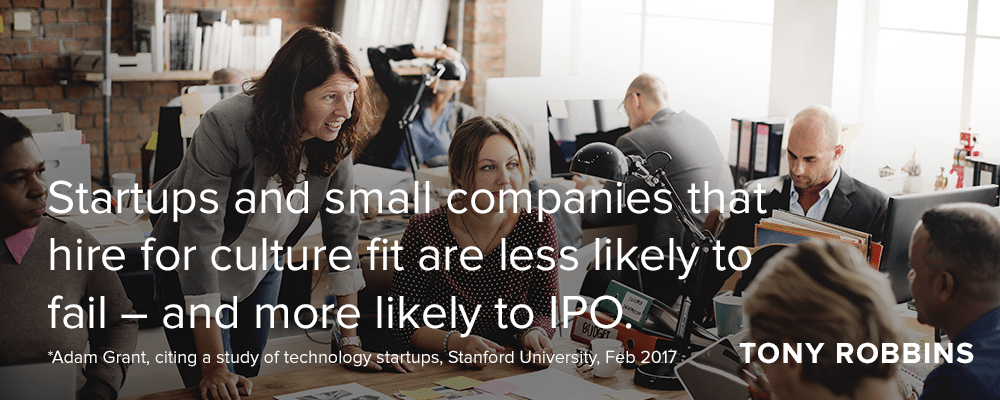Team Tony cultivates, curates and shares Tony Robbins’ stories and core principles, to help others achieve an extraordinary life.
Who should you hire first?
3 guidelines to make your first employees the best ones
One of the most challenging aspects of scaling a company is the hiring process. Not only is it costly to commit to an employee’s salary, it’s difficult to know whether or not your investment will yield the return you’re after. In fact, the average cost of finding, hiring and training a new employee rings in around $4,000. Add to that the pressure of making payroll and the increased liability of having a full-time employee, and the excitement of growing your team is suddenly eclipsed by the anxiety of the added risk.
Fortunately, there are ways to navigate through such a challenging decision. From knowing when it is time to bring someone on board to making smart hires, there are fundamental strategies and tactics that you can implement so that you can enhance and empower your team and your business. Because the right employee can create a seismic shift in your company – helping you increase bandwidth, start moving faster (a lot faster), and grow in new and exciting ways.
OUTSOURCE WHAT YOU CAN
When you start a business, you’re usually wearing multiple hats – you’re handling marketing, sales, operations, finances, perhaps even production. And while you are still in the seedling stages, that makes sense, particularly if you are bootstrapping. But at some point, you’ll be stretching yourself too thin, and it becomes obvious that your business is suffering for it. This is when you have to assess what to outsource and what to hire for.

In the beginning, it’s important to narrow down your team to a handful of people who can help you get your company’s product or service to market. Then outsource the remaining positions. And while that may seem simple enough, it starts with asking yourself a few questions:
- What are my own skills and abilities?
- What are my weaknesses?
- What duties in my business must be attended to regularly?
The answers, of course, will vary – depending on what industry you are in, where your business is located and what your personal strengths and weaknesses are. But conducting this assessment will help you get a better idea of what you should focus on in your business, and which roles you absolutely must hire for.
Then there is the question of what to outsource.
For many businesses, you will find that design work (such as web development and product packaging) is something that can be outsourced. Accounting is another area that can be outsourced, or even managed by software programs. And freelancers are an excellent source to tap for copy and even content.
As for marketing, see what you can do on your own before it is really time to make a hire. Innovative tactics and strategies such as influencer marketing and email marketing can be massively powerful tools that you can execute on your own. So get good at what you can.
The key here is to run as lean as possible until you have created a sustainable cash flow. Hire where you must in order to grow and prosper, and be tactical about what roles you outsource.
DON’T HIRE ON RÉSUME
In the nascent stages of a company, you aren’t looking to bring on high-level execs – you’re looking for uniquely motivated individuals, who are flexible and adaptable enough to potentially take on several roles in order to help your company grow. And while it may be tempting to choose the candidate with the impressive résume of Fortune 500 companies or years of investment banking expertise under their belt, that could actually work against you.
Those environments are highly-structured and contained. Working for establishments like that can mean the candidate is heavily focused on rules, regulations and fulfilling the functions of the role. Their positions serve as more of a cog in the wheel than a driving force that helps propel the company forward.
At a smaller company, there are often no strict rules or regulations when it comes to how to grow. Employees (even entry-level employees) are often encouraged to assume more roles, using their creativity to find solutions for the problems the company encounters along the way.
In your early stages, you need someone who can be a jack-of-all-trades – someone who can step into areas where that they may not necessarily have any expertise.
FOCUS ON CULTURE CONTRIBUTION
You know your business better than anyone else. You have established your brand identity, you know who your customer is, you have your mission. And now you are ready to grow a team that embodies every single aspect of your vision. But do you place the emphasis on skills or on culture fit?
Adam Grant recently spoke at Stanford University, addressing this very question. He asked the audience to consider Silicon Valley founders, explaining that they generally take one of three different approaches to hiring.
The first approach is all about hiring on skills – they have a job description, and want to hire someone who can competently execute each of the duties required of that position.
The second approach focuses on talent. This type of founder looks at the potential of the candidate – searching for the stars who have a lot of learning agility or raw intelligence.
Lastly, there is the approach that centers around culture fit. This founder may want skills and stars, but believes that all of that is a moot point if the candidate does not subscribe to their company’s values.

When researchers examined 200 startups in Silicon Valley, they found that the businesses that hired for culture fit were significantly less likely to fail – so much so, that their failure rate was actually 0%. They also found that those companies were more likely to IPO. And that makes sense, when you hire for culture fit, everyone has the same values – they share the same mission, and are all motivated to help advance that vision.
However, there is one caveat – researchers also found that after going public, those companies that hired on culture fit also experience the slowest growth rates. Why is that?
Adam Grant maintains that while this hiring approach may be powerful in the beginning when you are trying to drive an original idea forward and need to be aligned, when you are dealing with a constantly changing marketplace, you have to adapt. And culture fit equates to hiring a number of people who think in similar ways, which leads to “groupthink” and inherently eliminates “diversity of thought.”
What Grant recommends is based off the approach one of the world’s premier design firms takes. This company realized that rather than hiring on culture fit, they would hire on cultural contribution – that is, asking the candidate: “How would you make our culture even better?” This allowed them to find the individuals who were not only aligned in values, but thought in strategic ways that would help drive the company to new levels.
For more, see Tony’s essay on his Can Do, Will Do, Team Fit criteria.




